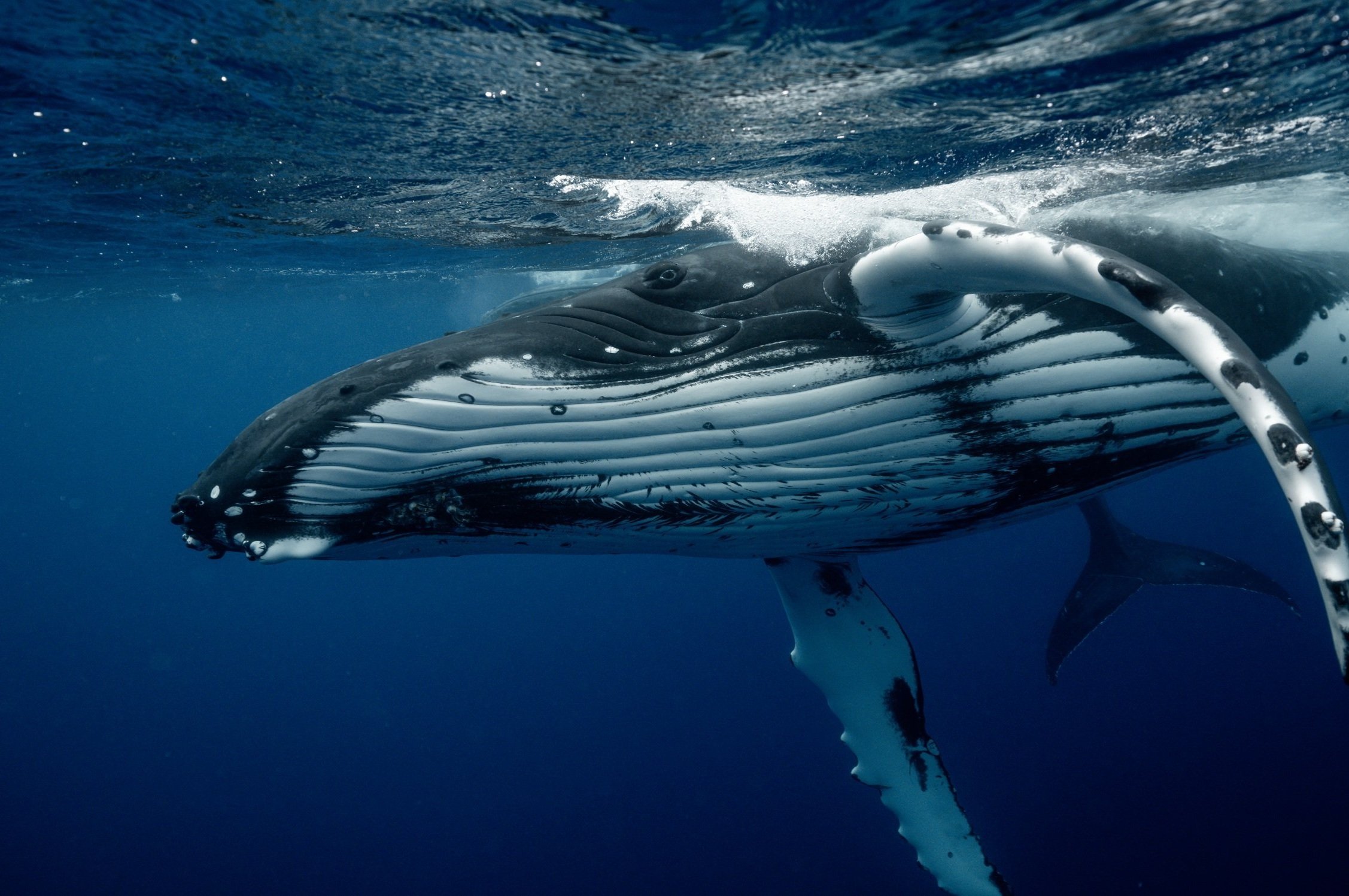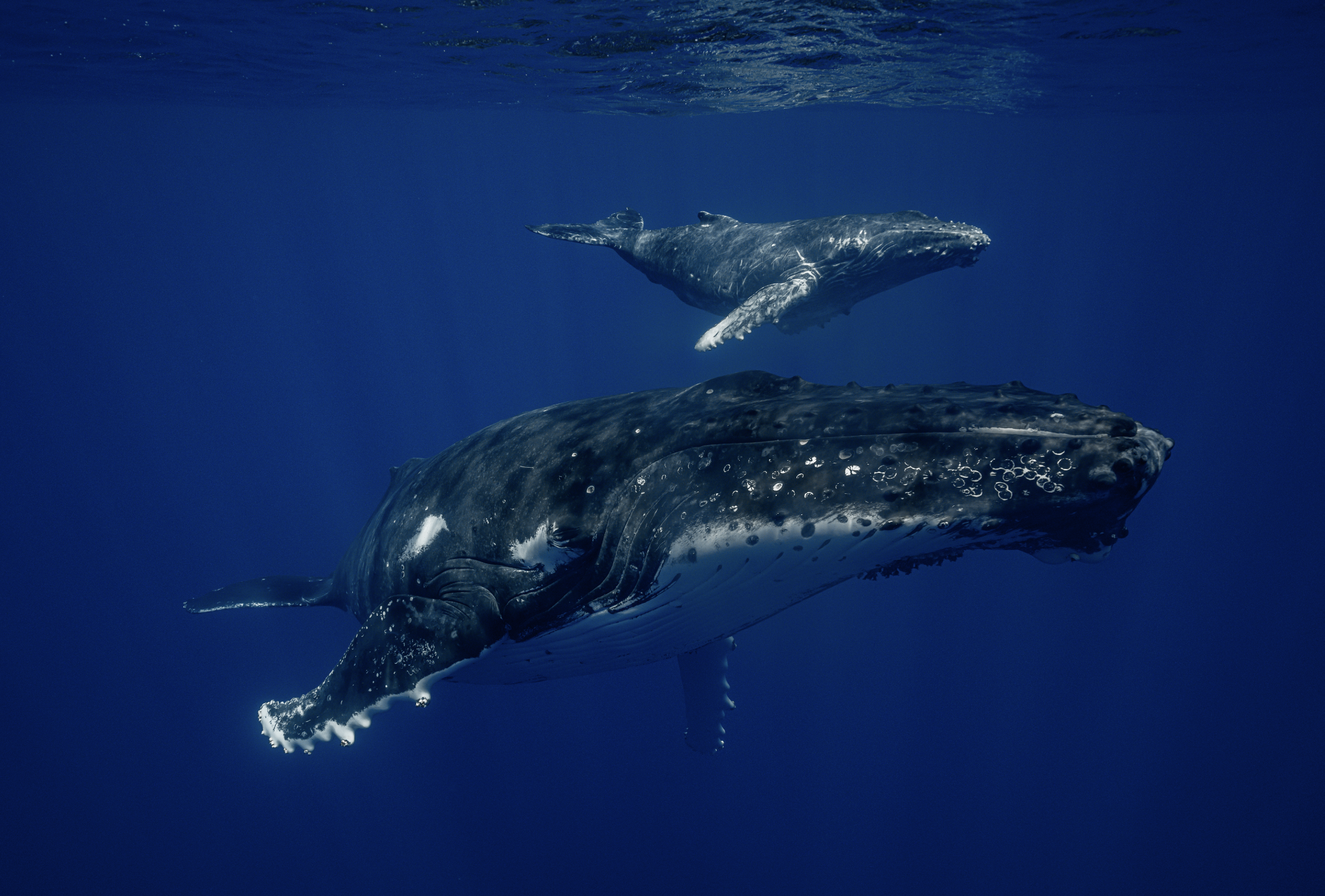
The Whales
The Migration, Whaling History, and Swimming with Whales
Humpback whales migrate from Antarctica to Rurutu’s warm shallows between August and October to give birth, nurse, and mate. The island’s reefs serve as nurseries, where mothers nurture their calves with fat-rich milk. Males compete for mates through displays ranging from subtle movements to dramatic breaches, revealing their social dynamics.
The Migration
Humpback whales embark on one of the longest migrations of any mammal, traveling from Antarctica to the warm, sheltered waters of Rurutu. These tropical waters, reached between August and October, are vital for birthing, nursing, and mating.
Rurutu’s fringing reef becomes a nursery and social hub where mothers guide their calves, which stay close for bonding and rely entirely on their mothers’ milk. These newborns, typically 10–15 feet long, depend on this nurturing for survival.
Males compete for females in a fascinating escort system, where a dominant male accompanies a female while others challenge for his position. These interactions range from subtle to dramatic, with displays like breaching and tail-slapping.
Swimming with whales requires patience, respect, and guidance. Your in-water guide will interpret the whales’ behavior, positioning you to observe without causing disturbance. Staying calm, grouped, and at a respectful distance ensures the whales feel comfortable, allowing for natural encounters.
Our approach is always on the whales’ terms—waiting for them to approach us. Boats maintain a minimum 100-meter distance, so be ready to swim at distance.
A Mother and Calf Pair: Mothers teaching their calves to swim is a frequent highlight.
Male Displays: You may witness males competing for dominance or attempting to court a female.
Social Groups: Occasionally, you’ll encounter pods of multiple whales interacting in playful or social ways.
Singers: Hear the haunting melodies of male humpbacks reverberating through the water.
The History of Whaling in Rurutu
For centuries, whales were hunted in Rurutu for their meat and oil, with the practice guided by traditional knowledge and rituals reflecting respect for the ocean. However, as global conservation efforts grew and modern influences reached Rurutu, attitudes shifted. By the mid-20th century, traditional whale hunts had largely ceased, driven by declining whale populations and changing cultural and economic priorities.
Today, Rurutu’s connection to whales has transformed from hunting to admiration. The annual humpback whale migration draws visitors for intimate whale-swimming experiences. Local guides, many descendants of whalers, now lead respectful encounters, sharing stories of their heritage while fostering a sense of pride and stewardship for these creatures. Whales, once a resource for survival, are now ambassadors of the island’s natural heritage.
This transformation symbolizes Rurutu’s embrace of sustainability and respect for marine life. Whale-swimming tourism not only supports the local economy but also serves as a bridge between tradition and conservation, demonstrating how cultural heritage and environmental responsibility can coexist to benefit both humans and whales.
A collection of photographs documenting whale hunting in Rurutu. Left: Locals share a baby whale during Rurutu’s last whale hunt in 1950. Top right: Natapu, one of the last whale hunters of Rurutu, stands with his harpoon. Bottom right: Locals catch a whale in Rurutu in 1950. Photographs by Moanaura Walker. Credit: Tahiti Heritage.
Swimming with the Whales
Swimming with whales in Rurutu is a unique experience requiring respect and adherence to strict guidelines. Boats stay at least 100 meters from whales, so swimmers must be prepared to cover this distance and back in open water. Fitness and comfort in the water are essential, as whales can move quickly with just a few tail pumps.
Close approaches are always initiated by the whale. Stop swimming about 15 meters away, or when you can see the white markings on their pectoral fins. Stay behind your guide and in a tight group with fellow swimmers to improve interaction chances. Remaining still and silent in the water further encourages whales to approach.
Humpbacks surface to breathe every 10–20 minutes, while curious calves may interact more frequently under their mothers’ watchful eyes.
Starting in 2025, only six guests will be allowed in the water at a time, ensuring intimate encounters and minimizing stress on the whales.








